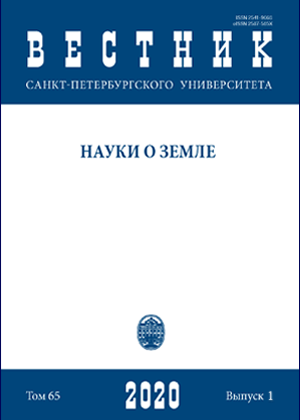Уровень аккумуляции и формы нахождения тяжелых металлов в донных отложениях малых озер урбанизированной среды (Карелия)
DOI:
https://doi.org/10.21638/spbu07.2020.109Аннотация
В статье приводится детальный анализ эколого-геохимических особенностей донных отложений двух малых озер, расположенных в черте г. Петрозаводска (Республика Карелия). Отбор проб озерных осадков был проведен в 2016 и 2018 гг. при помощи торфяного бура для глубоких слоев отложений и пробоотборника Limnos для современных слоев донных осадков. В лабораторных условиях после просушки и истирания образцы были проанализированы на содержание в донных отложениях главных элементов и тяжелых металлов при помощи рентгенофлуорисцентного спектрометра и масс-спектрометра с индуктивно связанной плазмой. Оценка форм нахождения тяжелых металлов в отложениях озер г. Петрозаводска была выполнена методом последовательной экстракции химических элементов. Для экологической интерпретации полученных результатов были рассчитаны суммарный показатель загрязнения и индексы геоаккумуляции для каждого из водоемов. В результате было установлено, что озера имеют разную геохимическую спецификацию и различный уровень загрязнения тяжелыми металлами. Наибольший уровень накопления в донных отложениях по сравнению с фоном отмечен по Pb, Sb, V, Cu, Zn, W и Bi. При этом отложения оз. Четырехверстного характеризуются уровнем загрязнения от низкого до среднего, а осадки оз. Ламба — от низкого до очень сильного. Почти все металлы преимущественно находятся в минеральной форме в донных отложениях, однако значительная часть загрязнителей имеет сродство с обменными катионами (подвижная форма) и органическим веществом озерных осадков, что представляет существенную опасность для миграции загрязнителей по системам «донные отложения — вода» и «донные отложения — биота».
Ключевые слова:
тяжелые металлы, донные отложения, формы нахождения загрязнителей, малые озера, урбанизация, Республика Карелия
Скачивания
Библиографические ссылки
Загрузки
Дополнительные файлы
Опубликован
Как цитировать
Выпуск
Раздел
Лицензия
Статьи журнала «Вестник Санкт-Петербургского университета. Науки о Земле» находятся в открытом доступе и распространяются в соответствии с условиями Лицензионного Договора с Санкт-Петербургским государственным университетом, который бесплатно предоставляет авторам неограниченное распространение и самостоятельное архивирование.






